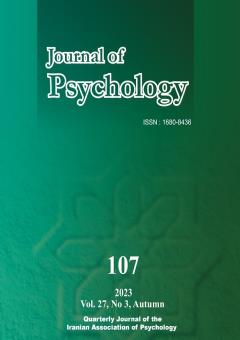-
-
List of Articles
-
Open Access Article
1 - Developing of Self-Destructiveness Model, based on Ego-Development Level
Ashraf Sadat Mousavi parviz azad fallah hojatollah farahani -
Open Access Article
2 - Comparison of emotion-focused couple therapy and Guttman couple therapy On the marital compromise and the four horses that destroy the couple
Leila Jafari Isaac Rahimian Boogar, Jamshid Jarareh علی تقوائی نیا -
Open Access Article
3 - perception of Parenting Styles and Thriving in Emerging Adulthood: The Mediating Role of Life- management strategies
reyhane eskandari Elahe Hejazi zahra naghsh -
Open Access Article
4 - Psychometric Indices of Zuckerman's Sensation Seeking Scale: A Factor for Predicting Students’ Academic Procrastination
hamidreza hassanabadi seyed saeed torabi -
Open Access Article
5 - Investigating the Factor Structure and Psychometric Properties of the Persian Version of the Lay Beliefs about Competition Scale
Mohsen Arbezi -
Open Access Article
6 - Comparing Attentional Bias to Facial Expressions of Pain and Coping Styles between Individuals with Migraine and Controls
Zahra Zarei Khatereh Borhani Farzad Ashrafi Setareh Mokhtari -
Open Access Article
7 - Design and test a model of personality relationship with corona dissease anxiety mediated by perceived stress and self-efficacy in adolescents
Elahe Aslami Farzaneh Khani Mehrabadi Azam Tadayon -
Open Access Article
8 - Investigating the relationship between family communication patterns and academic vitality: The mediating role of self-regulated learning strategy
محسن علیزاده Siruos Alipor Birgani Manijeh Shehniyailagh -
Open Access Article
9 - Comparing the Effectiveness of Transcranial Direct Current Stimulation and Cognitive Behavioral Therapy Treatments on Sexual Desire Disorder in Men
hossein ranjbar shayan Seyed Mahmoud Tabatabaei Amir Panah Ali -
Open Access Article
10 - The Mediating Role of Psychological Distress in the Relationship between Inferential Confusion and Obsessive-Compulsive Symptoms
Zahra Khosravi Roubiat Mahmoud Najafi -
Open Access Article
11 - The role of physical health and psychological pain in the prediction of suicide attempt: mediating factor of distress tolerance and self-directed aggression
Fateme Habibi Isaac Rahimian Boogar,
-
The rights to this website are owned by the Raimag Press Management System.
Copyright © 2017-2025







